Conversion Revolution: From Abandoned Carts to Actual Sales in 8 Hours
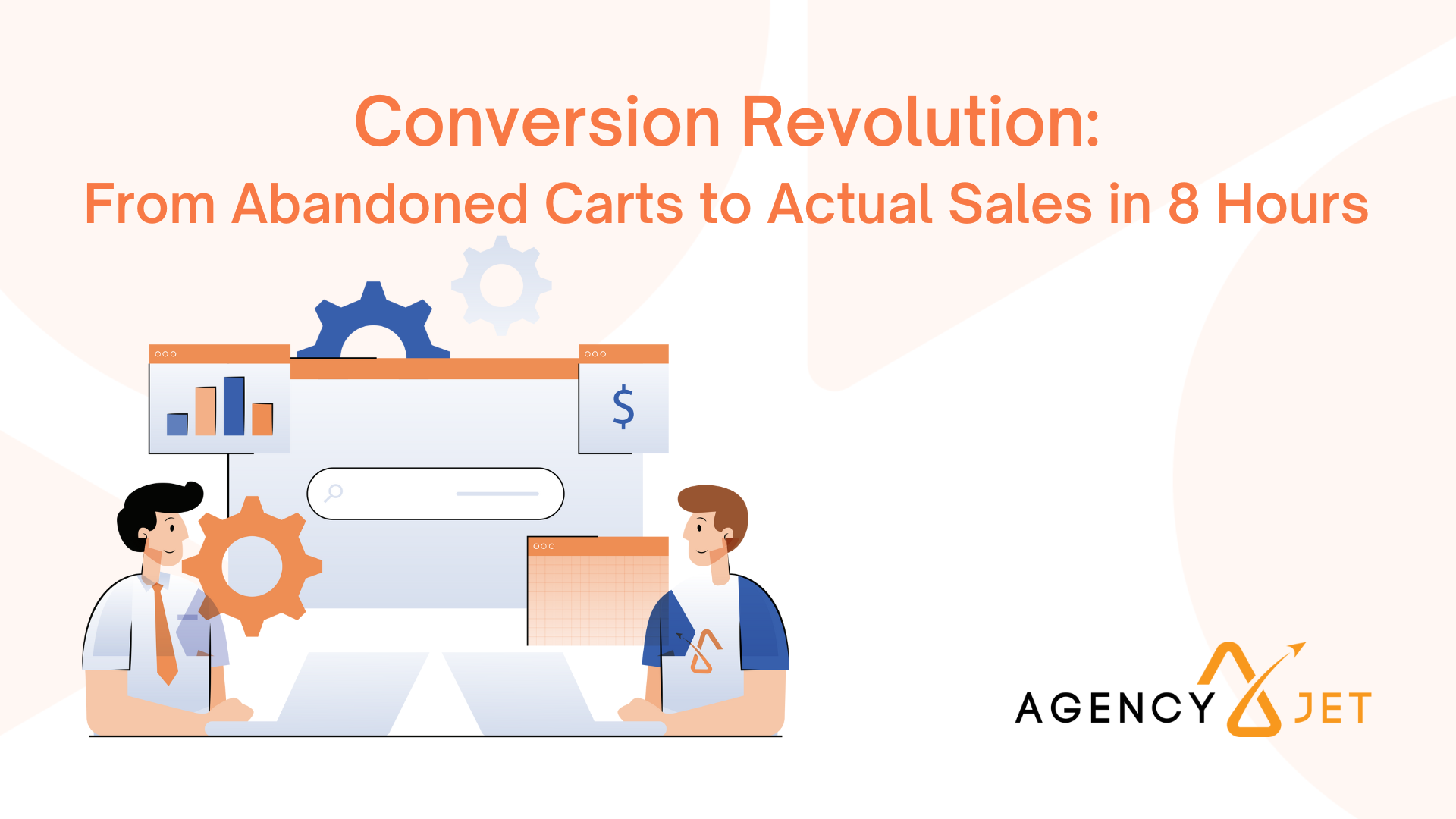
Abandoned carts are the bane of any e-commerce owner’s existence, costing them billions of dollars in lost revenue annually.
In a study by Baymard Institute, 69.99% of carts are abandoned, and digital marketing services are often scrambling for ways to reduce abandonment rates.
With customers having more choices than ever, it’s becoming increasingly difficult to get them to complete their purchases in your store. To make matters worse, abandoned carts can be notoriously hard to track and even harder to convert back into actual sales. It’s easy to get frustrated watching all those potential customers slip away without warning.
In this post, we’ll share strategies that can help you reduce abandoned carts, increase conversion rates, and ultimately grow your business.
The True Cost of Abandoned Carts
While the financial impact of abandoned carts can be quantified through lost sales, the other associated costs can be more challenging to pin down.

Beyond the immediate financial loss from a customer abandoning their cart, additional costs related to customer acquisition and inefficiencies in the website conversion funnel are also at stake.
If your funnel isn’t optimized—whether due to a complicated checkout process, slow loading times, or a lack of payment options—customers are more likely to leave before completing their purchase.
Don’t believe us? Just take a look at some of the stats on abandoned carts:
- The global value of recoverable sales just by improving usability issues would be $260 billion.
- You’ll lose an average of $58 per abandoned cart.
- 90% of shoppers abandon their carts if the website and the loading time are too slow.
These statistics nail the importance of identifying abandoned carts and taking action to convert them. This is absolutely true when it comes to increasing revenue and reducing customer churn.
The good news is that you can implement a few simple strategies to turn abandoned carts into actual sales. Here are some strategies to get you started.
Simplify the Checkout Process
A long and complicated checkout process is a major turn-off for many shoppers. In their defense, it’s often hard to keep track of all the steps involved in completing a purchase.
Make it easier for your customers by streamlining the checkout process and cutting out unnecessary steps. The less friction your customers experience, the more likely they will complete their purchase.
Image:
Please design an image depicting a nicely designed website.
User experience is a critical aspect of successful e-commerce conversion. When it comes to turning abandoned carts into actual sales, an important part of the user experience is creating a seamless and intuitive checkout process. The more streamlined and efficient it is, the more likely customers are to complete their purchase.
Minimize Distractions During Checkout
Ever encountered a popup or an ad while trying to check out? These can be highly distracting and interfere with the checkout process. Or maybe you’ve been caught in an endless loop of checkouts and confirmations? All of these can be frustrating for customers and a big reason why they abandon their carts.
Your checkout page should be just that: a page dedicated to checking out. Keep distractions at a minimum and ensure the process is as focused, streamlined, and hassle-free as possible.
Reduce the Number of Form Fields
Just like physical stores, digital stores must collect customer information during checkout. Collecting too much information, however, can be unappealing to customers. It also increases the bounce rates.
Determine what information you need to get the purchase going and deliver the product to their doorstep. The fewer fields they need to fill, the better. Here’s a list of information you’ll need at checkout:
- Name
- Address
- Phone number
- Email address
That’s as bare bones as possible, which is precisely what you should aim for.
Offer Payment Options Beyond Credit Cards
Here’s the thing: not all customers prefer to use credit cards. Some may be more comfortable with other payment methods like PayPal, Apple Pay, or Amazon Pay. Make sure you offer multiple payment options to cater to the needs of a broad customer base.
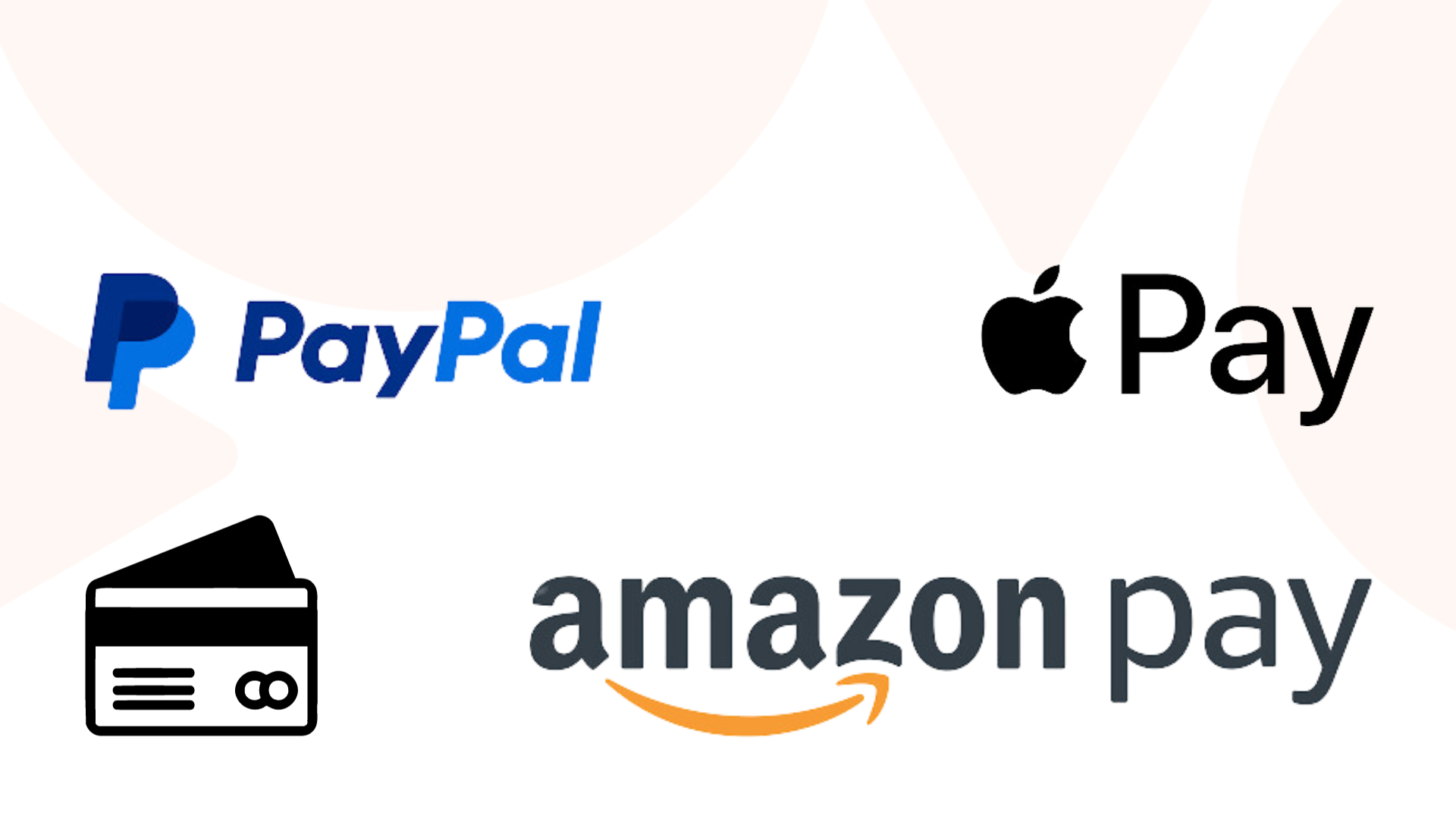
64% of online shoppers think e-commerce stores don’t really know them. Make sure to break this statistic by offering payment options that your customers prefer.
Add Security Features To Increase Trust
We’ll discuss this bit in more detail later, but it’s essential that you put measures in place to make your customers feel secure. Use SSL encryption and display trust symbols prominently throughout checkout to increase customer trust.
After all, the last thing you want is for your customers to feel like their payment data isn’t secure.
Optimize for Mobile Users
In 2023 alone, about 1.31 billion business transactions will be made through mobile. To put that into perspective, that’s about 20% of the global population! This means mobile optimization is essential to increasing your website conversion rate.
Responsive Design
Responsive design refers to the design of a website that automatically adapts to different screen sizes and devices.
This ensures that your checkout page is optimized for mobile users and gives them a hassle-free experience on their phones or tablets. It is important to ensure that your website provides a positive mobile experience.
For example, the buttons should be big enough to easily tap on, and the form fields should be easy to fill out, no matter what device they’re using.
A responsive design for your carts and checkouts is a must-have in the current era of digital business.
Mobile-friendly Payment Options
Speaking of mobile users, offering payment options optimized for small screens is a must. Mobile-friendly payment options like Apple Pay or Google Pay allow customers to complete their purchases with just a few taps on their phone.
Options for PayPal and Amazon are also available as they tailor their payment gateways to fit mobile devices.
Intuitive Navigation
Mobile e-commerce is all about making the most of small screens. Your checkout page should be intuitive and allow easy navigation with minimal clicks.
You can do this using a single-column layout and ensuring no unnecessary scrolling. Every step in the checkout process should be clear and concise so customers know exactly where they are going with each click.
Your cart recovery journey should include the following navigation elements:
- A progress bar to indicate the number of steps left in the checkout process
- Clear labels and headings for each step
- Simple back-and-forward buttons or links that are easy to click
If you’re unsure how to go about this, don’t worry! There are plenty of digital marketing services that come with built-in mobile optimization features.
Build Trust and Address Security Concerns
Scams, phishing, and identity theft are just some security concerns customers have when shopping online. This is why building trust with your customers is essential to increasing conversions and reducing abandoned carts.
You don’t want to scare your customers away due to security concerns. Instead, you should take proactive steps to assure customers that your website is secure and your payment process is protected.
Security Badges and Trust Seals
The best way to display your company’s credibility is through security badges and trust seals. These easily recognizable symbols communicate to your customers that their data is safe when they’re shopping on your website. Common examples of these symbols include:
- Norton Security
- VeriSign Trust Seal
- McAfee Secure
These are not symbols you can get quickly, though. Your systems must be genuinely safe and reliable for you to get them. That said, this extra step is a great way to increase conversions and reduce abandoned carts by showing your customers that their data is safe with you.
Secure Payment Options From Trusted Providers
Speaking of security, you should also ensure that the payment processors you use are secure.
Payment gateway services like PayPal and Stripe have built-in fraud detection technology and encryption to protect customers’ data. They have a solid reputation in e-commerce, so customers will feel more comfortable providing their information to these trusted providers.
Other payment options you should consider include the following:
- Apple Pay
- Amazon Pay
- Google Pay
- Credit cards
- Bank transfers
For retailers, we recommend payment options like Afterpay and Klarna. These installment-based payment systems allow customers to purchase items now but pay in installments over a certain period.
B2B businesses should look into ACH payments or direct debit. Companies often prefer these payment options because of their low transaction fees and faster processing times.
Transparent Return Policies
Despite all your efforts to ensure high-quality products and customer satisfaction, sometimes customers may want to return their purchases.
Like it or not, customers want to be able to do so without jumping through hoops. Having too many steps in your return policies shows them that you are not confident in your products or services.
Ensure your return policies are clearly outlined and easy to find to prevent abandoned carts and increase your website conversion rate.
Also, consider offering free returns with no questions asked, as customers are more likely to convert when there is no risk involved. This shows them that you genuinely care about their satisfaction and are willing to do what it takes to make them happy.
Remember: The easier you make it for customers to return products, the more likely they are to trust your business and come back again.
Enable Guest Checkout
Guest checkout allows customers to make purchases without creating an account. This is beneficial for customers who don’t want the hassle of creating yet another account and those who may be concerned about their data being stored on your website.

In fact, 24% of customers leave their carts just because the website wanted them to create an account.
By making purchasing simpler, guest checkouts reduce friction for individuals who want to buy your products but don’t want the additional hassle of signing up for an account.
Account Creation Tips
Before we get further, let’s dive into best practices when integrating account creation as an e-commerce strategy.
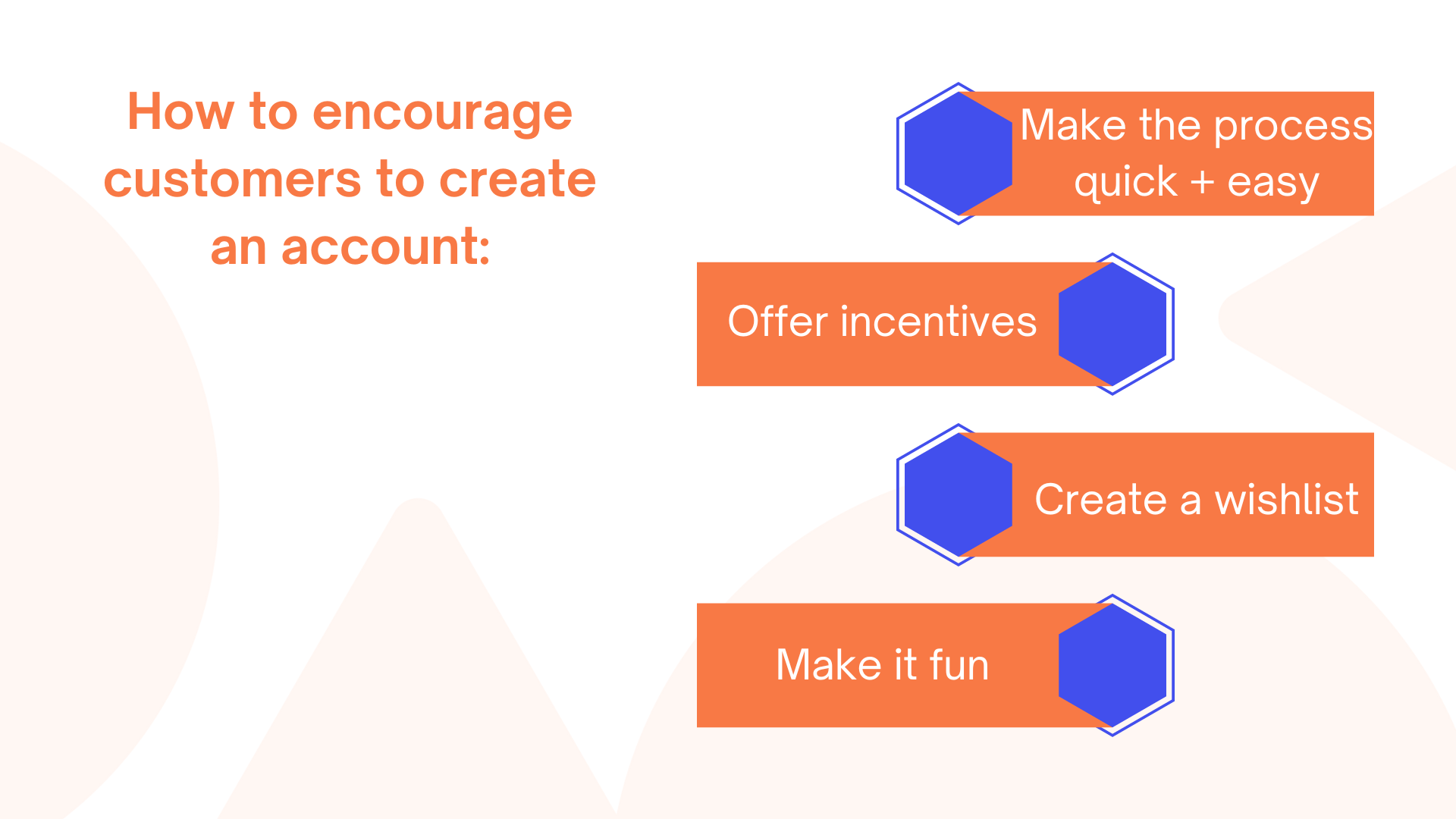
Here are some ways to encourage customers to participate in account creation:
- Make the process quick and easy: Make sure the signup process is simple so users don’t get frustrated or overwhelmed while creating an account.
- Offer incentives: Give customers something in return for signing up, like discounts on their first purchase or free shipping.
- Create a wishlist: Give customers the ability to save items they’re interested in so that they can return to them later and complete their purchase.
- Make it fun: Design your account creation process in an enjoyable way by including visuals or entertaining copy.
- Include social logins: Let customers use their existing social media accounts (e.g., Facebook, Twitter, etc.) to quickly create an account. This simplifies the process and makes it easier for customers to login in the future.
These strategies add more value to account creation and don’t make it seem like an annoying chore for customers.
Optimize Cart Visibility and Navigation
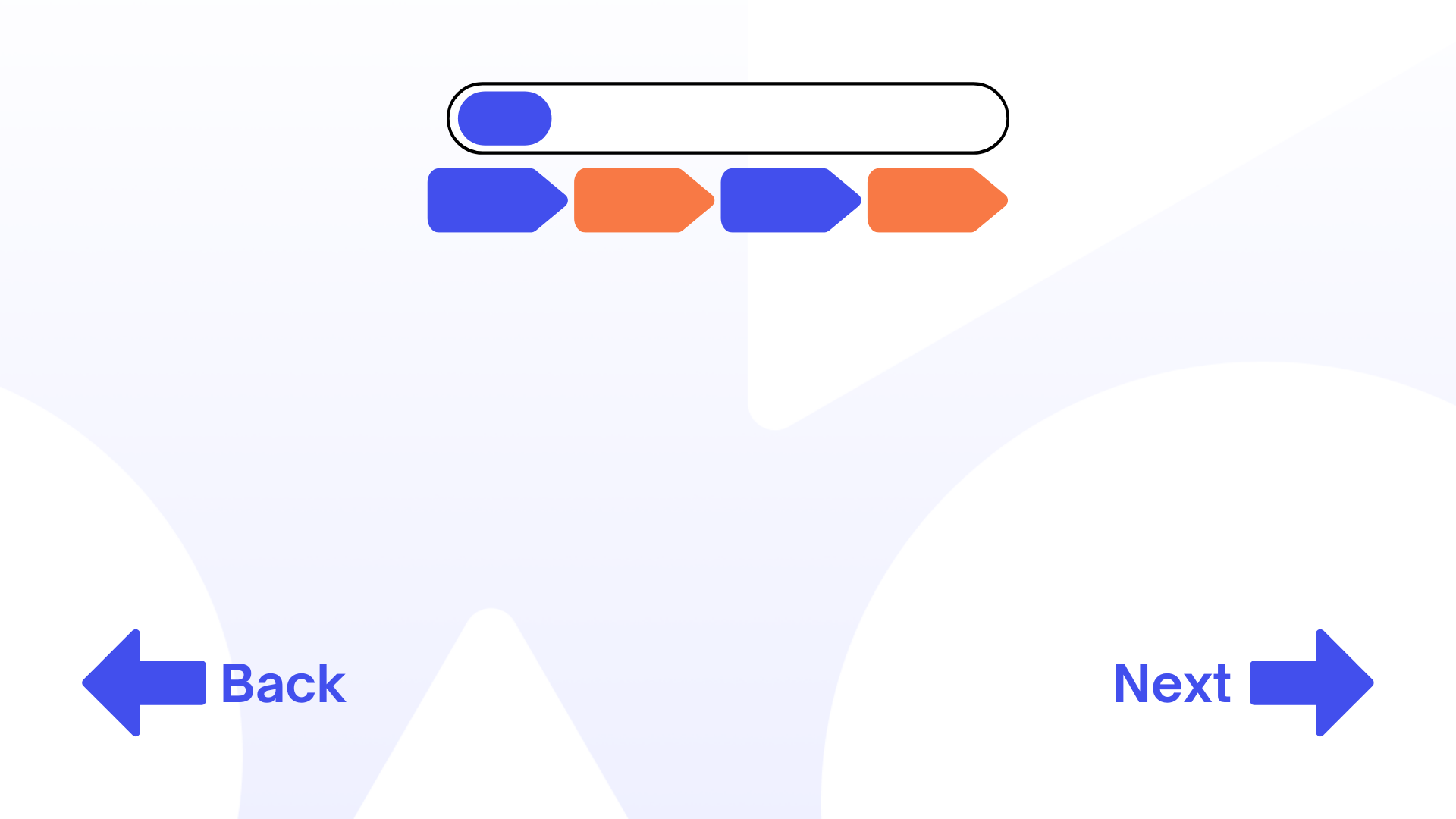
A cart icon is more than just a reminder that customers have products in their cart — it’s an invitation to complete the purchase. From the first page, customers should be able to easily access their cart from any page and on any device.
If you want to boost your website conversion rate, it’s time to optimize your cart navigation and visibility. Here are three ways to achieve this.
1. Provide Clear Cart Summaries
A cart summary is a great way to optimize the checkout experience and show customers what’s in their cart. It should include:
- Product names
- Images
- Prices
- Any relevant promo codes or discounts
16% of customers who are at the checkout want to see what exactly is in their cart before they even make the purchase. They want to know the actual cost of their purchase before they hit “buy now.”
For example, Amazon shows customers a clean and easy-to-read cart summary that allows them to edit or delete items. Simplifying this process helps customers make informed decisions and is more likely to lead to a successful purchase.
2. Make the Cart Persistently Visible
As we said, your website’s cart should be everywhere your customer goes. This is not just because you want them to click “buy” — it’s also so they can access their cart anytime.
Ensure your website’s cart is visible in the top navigation bar, product page, and everywhere else within the customer journey.
This makes them feel more secure that all their added items are not lost. It also allows them to easily add or remove items before they checkout.
3. Increase Content Accessibility
Navigating your cart shouldn’t be a challenging task. That’s why you should ensure the checkout process is as easy as possible and that all content is accessible from any device.
Content accessibility involves several things, including:
- Ensuring your website is mobile-friendly
- Making sure all content is visible on any size screen
- Reducing the number of steps required to complete a purchase
- Providing clear, concise instructions for filling out forms
While content accessibility in carts varies from industry to industry, a good rule of thumb is to keep the process as efficient and straightforward as possible.
Leverage Persuasive Product Recommendations
Even carts have to be “sold,” and that’s where persuasive product recommendations come into play. These are strategically placed products to entice customers to add more items to their cart and complete the purchase.
There is science behind this strategy called “nudging,” — and it works. Nudge marketing is the process of influencing customers to make a purchase decision by subtly suggesting they buy certain items. This can be done through product recommendations, upsells, and cross-sells.
For abandoned carts, you can use them as an opportunity to suggest relevant products.
Amazon does this very well. When customers abandon their carts, they are presented with personalized recommendations and discounts to help them complete the purchase.
It’s also a good idea to provide visual cues like product ratings or customer reviews, which could give shoppers more confidence in clicking “add to cart.”
Reviews and customer testimonials are important factors that provide trust signals to visitors.
Leveraging Personalization
Personalization plays a huge role in the success of this strategy. However, personalization takes much more than knowing your customers’ names. You’ll have to leverage various data points to truly personalize the experience.
Some data you can use include:
- Demographic and profile information
- Geolocation
- Previous purchase history
- Product preferences
This data can create dynamic recommendations for customers in real time while giving them the feeling that you know their needs.
Machine learning and data-driven automation significantly enhance your ability to personalize your interaction inside customer carts.
For example, you may have discovered that a specific segment of customers is more likely to buy a certain item. Targeting this segment with personalized product recommendations can help increase conversions and reduce abandoned carts.
Machine learning takes this one step further by tweaking and optimizing product recommendations based on customer data. This testing, learning, and refining cycle helps you refine your strategies and maximize conversions.
Adding Visuals to Recommendations
Persuasion isn’t just words. That’s why adding visuals to product recommendations can be an effective way to increase conversions.
Visuals like images, videos, and animations are powerful tools that help customers feel connected to the product and make their decision-making more manageable.
It’s important to note that your visuals must be relevant to what you’re offering. For example, if you suggest another pair of shoes, you don’t want to show a picture of a dress.
Any visual cues in your cart should aim to communicate the value of what you’re offering and persuade customers to take action.
Offering Discounts or Special Deals
Product recommendations work best if customers get something in return. Dive deep into your customer’s behavior and ask yourself, “What do they want?”

Your promos and deals don’t have to be expensive. Even small incentives can be enough for customers to complete the purchase.
For example, you could offer a 10% discount on their next order if they finish purchasing today’s items in their cart. You could also offer free shipping after spending a certain amount of money.
Collecting User Feedback
Remember when we said that part of the process involves testing, learning, and refining? Well, collecting user feedback provides you with valuable insights that you can use to refine your strategies.
Collecting user feedback could take many forms, such as:
- Surveys
- Reviews
- Polls
As first-party data becomes even more critical due to increasing privacy and data protection regulations, customer feedback can help ensure that your strategies and recommendations align with customer expectations.
Utilize Remarketing and Abandoned Cart Emails
Why is shopping cart abandonment a problem for retailers? The answer is that shoppers often get distracted and forget to finish their purchases.
Remarketing campaigns and abandoned cart emails are effective ways to recover lost sales. There are two approaches you can take when it comes to remarketing:
- Target shoppers who have abandoned their carts with reminders of what they left behind.
- Target shoppers who haven’t yet purchased by offering additional incentives if they buy now.
These campaigns provide an excellent opportunity for retailers to remind customers why they should complete the purchase and offer discounts or special deals.
Of course, you must ensure that your campaigns are worth reading and clicking through. Here are some tips to help you get started with this:
- Create a captivating subject line to grab the customer’s attention.
- Personalize your message by addressing the customer by name.
- Use relevant images and visuals to showcase your products or services.
- Keep it short and sweet with concise copy that quickly gets to the point.
- Include a clear call-to-action (CTA) with a sense of urgency.
- Ensure to link back to the exact product pages or cart pages that customers left behind.
- Utilize automation and A/B testing to optimize your campaigns for maximum efficiency.
Remarketing and email campaigns work best when you understand when to time them.
Targeting customers at the right time is crucial to boost conversions, so make sure that you establish a timeline for your abandoned cart emails and remarketing campaigns. Targeting them too early or too late can result in a lower ROI.
Use Google Analytics
Google Analytics is a powerful tool that can help you analyze and optimize your checkout process in order to convert abandoned carts into actual sales.
With Google Analytics, you can easily identify areas of improvement in your checkout process. You can understand where customers drop off and why they don’t complete their purchases.
Using Google Analytics, you can track the entire customer journey from start to finish and track your conversion goals.
If you have a strong interest in data analysis and observing user behavior, HotJar is a tool worth considering. You will have the opportunity to view session recordings.
Creating a Conversion Funnel for Better Results
A conversion funnel is a process used to convert website visitors into customers. It starts at the top of the funnel, where potential customers are introduced to your business and ends at the bottom of the funnel when those customers become paying customers. In between these two points lies all of the steps that allow businesses to reach their desired outcome – converting website visitors into paying customers.
The conversion funnel is a tool used by marketers to help identify where potential customers get stuck in the buying process. It helps you understand why people leave your website without making a purchase, and what steps you can take to encourage them to convert.
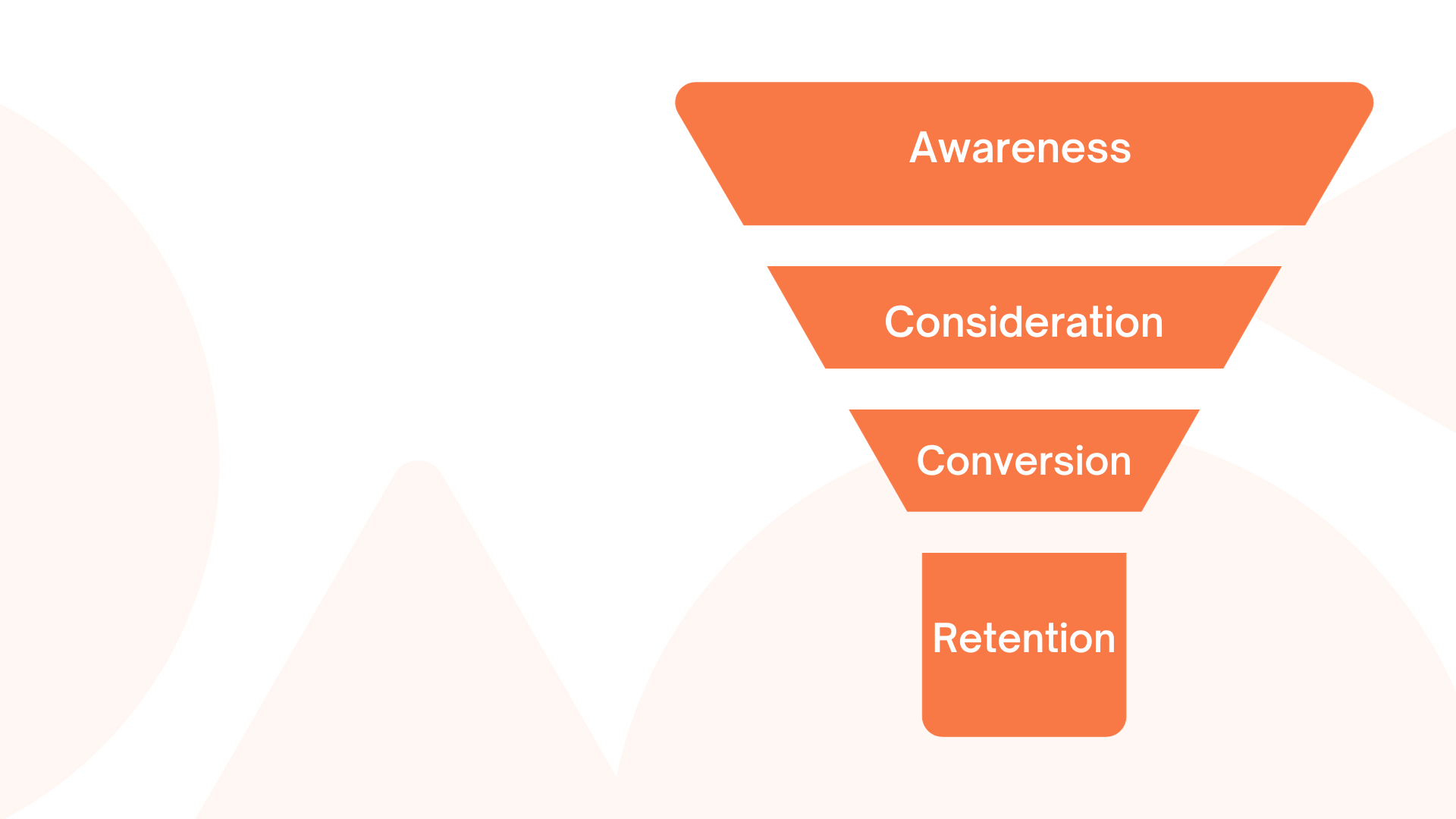
At its core, a conversion funnel consists of four main stages: Awareness, Consideration, Conversion, and Retention.
The primary goal for most business owners is conversions.
Convert More Carts Today!
It’s time to optimize your e-commerce store for higher conversions and lower abandoned cart rates. By applying the principles of human behavior science, you can create an experience that converts in just eight hours!
But if all this sounds intimidating or overwhelming, don’t worry. Our conversion experts at Agency Jet are ready and waiting to partner with you on a free web audit. Our digital marketing services identify any areas needing optimization so you can increase sales without breaking the bank.
Your business will 100% not scale if your abandonments remain high. And our website assessment is 100% free to make sure you know how to stop abandonment. Contact us today, and let’s transform potential losses into profits and provide free conversion rate optimization tips.
